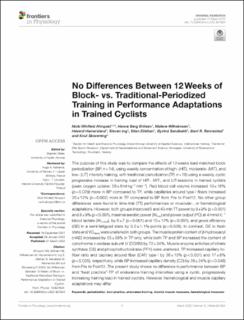| dc.description.abstract | The purpose of this study was to compare the effects of 12 weeks load-matched block periodization (BP, n = 14), using weekly concentration of high- (HIT), moderate- (MIT), and low- (LIT) intensity training, with traditional periodization (TP, n = 16) using a weekly, cyclic progressive increase in training load of HIT-, MIT-, and LIT-sessions in trained cyclists (peak oxygen uptake: 58 ± 8 ml·kg−1·min−1). Red blood cell volume increased 10 ± 16% (p = 0.029) more in BP compared to TP, while capillaries around type I fibers increased 20 ± 12% (p = 0.002) more in TP compared to BP from Pre to Post12. No other group differences were found in time-trial (TT) performances or muscular-, or hematological adaptations. However, both groups improved 5 and 40-min TT power by 9 ± 9% (p < 0.001) and 8 ± 9% (p < 0.001), maximal aerobic power (Wmax) and power output (PO) at 4 mmol·L−1 blood lactate (W4mmol), by 6 ± 7 (p = 0.001) and 10 ± 12% (p = 0.001), and gross efficiency (GE) in a semi-fatigued state by 0.5 ± 1.1%-points (p = 0.026). In contrast, GE in fresh state and VO2peak were unaltered in both groups. The muscle protein content of β-hydroxyacyl (HAD) increased by 55 ± 58% in TP only, while both TP and BP increased the content of cytochrome c oxidase subunit IV (COXIV) by 72 ± 34%. Muscle enzyme activities of citrate synthase (CS) and phosphofructokinase (PFK) were unaltered. TP increased capillary-to-fiber ratio and capillary around fiber (CAF) type I by 36 ± 15% (p < 0.001) and 17 ± 8% (p = 0.025), respectively, while BP increased capillary density (CD) by 28 ± 24% (p = 0.048) from Pre to Post12. The present study shows no difference in performance between BP and “best practice”-TP of endurance training intensities using a cyclic, progressively increasing training load in trained cyclists. However, hematological and muscle capillary adaptations may differ. | en_US |

